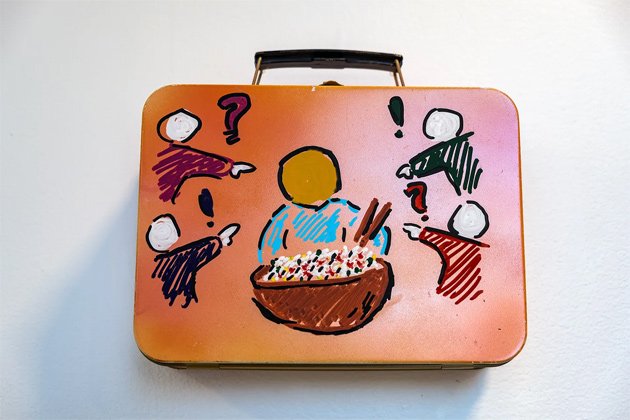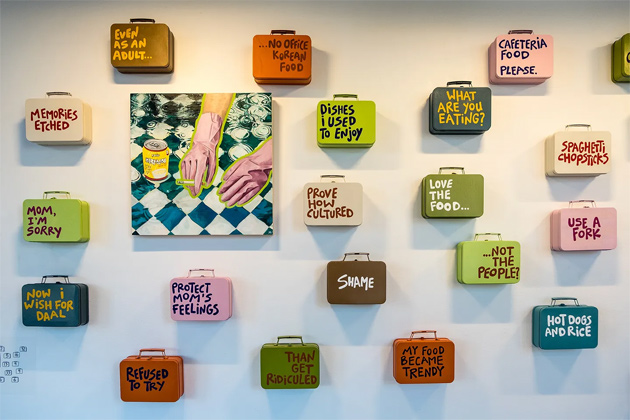
One of the lunchboxes created at a Boston workshop.
Lunchbox Moments: Seek Understanding. Share Stories. Stop Hate
Pao Arts Center
99 Albany St., Chinatown
Through Saturday, Feb. 17, 2024
When did you realize that you were different?
For most of us, there isn't just one singular moment. We have entire lifetimes of collected memories where we come in and out of focus, blending in and contrasting against the world around us and noticing how we, our cultures, our families, or our traditions are or are not the norm.
The idea of a "lunchbox moment" has emerged as one such familiar point of connection for many within the Asian American and Pacific Islander (AAPI) community. It can be defined as a formative moment in which a traditional Asian meal was brought to school and elicited some sort of reaction from non-Asian peers.
In order to share these stories and empower the AAPI community, artist Amie Bantz has collected many of these lunchbox moments and curated them into Lunchbox Moments: Seek Understanding. Share Stories. Stop Hate, which is currently on display at the Pao Arts Center until Saturday, February 17, 2024.
As Bantz says "I have a lunchbox moment; my mom has a lunchbox moment; nearly all of my AAPI peers have a lunchbox moment. These stories make up a collective identity that is equal parts profound, beautiful, comical, and heartbreaking."

The show consists of excerpts from these stories printed on lunchboxes, accompanied by Bantz's paintings, which depict bright, ambiguous scenes filled with cultural motifs and small gestures.
In one painting, pink, gloved hands surrounded by neon green are submerged in water next to what appears to be a Korean rice punch drink. In another, a couple in older-style dress occupy the bottom half of the frame while what appears to be a study of differently-shaped eyes occupies the top.
The connections and images are familiar yet strange, specific and yet evocative, much like the text that surrounds them.
The rows of lunchboxes on the wall of the gallery are tidy. So are many of the stories that accompany them, which are provided both through QR code and a physical pamphlet. Most of these stories have the same contours, and evoke similar feelings around difference, cultural identity, shame, and family. These are stories of being othered and bullied, the lunchbringers feeling in some way advertised in their difference, even in their own minds.
There's something simple, bright, and sunny about the lunchboxes thath face the world, but something much more complex, intimate, and personal about the notes collected in the book. This seems fitting, as many of the stories spoke about learning to become different people at school and at home, compartmentalizing feelings of hurt, or navigating selves that span multiple cultures.
As I sat down and read a book that accompanied the catalog, I was surprised at how immersed I became. Each story had commonality, and yet remained wholly unique and personal. There were stories of smelly lunches, accusations of eating dog, throwing away lunches of buying lunch for fear of ridicule, and pining for Lunchables.
Many stories spoke to a very human desire to be accepted and to fit in. But there were also moments of friendship, humor, and gratitude.
One writer remembered trading basmati rice with yellow daal for Spaghettios. Another remembered wanting mac and cheese and being presented with white rice with a Kraft single melted on top.
There were many expressions of gratitude for parents as note-writers recounted their memories of registering their parents' hurt at their small rejections, or retrospectively realizing how hard their parents tried to help them find acceptance at school or put into the preparation of their food.
"Mom, I'm sorry. If I could go back I would eat those lunches with pride," expressed one anonymous note-writer.
While the lunchboxes themselves were an old-fashioned metal style, which evoked childhood and nostalgia and also time gone by, many stories occurred beyond childhood.
"When I was newly out of college I was eating something with chopsticks and my roommate's boyfriend said, ‘Why don't you just use a fork? Why would you use chopsticks to eat that since the fork has been invented??'" another anonymous note read.
For many, their lunchbox "moment" was not confined to one moment in the past, but continued to ripple throughout their lives, transforming into other moments and complicating, rather than simplifying, with age. Many addressed how the evolution of America's culinary tastes and resulting popularization of Asian foods has left them with a confusing aftertaste. One note-writer expressed that the co-opted Americanized versions of foods leave behind the culture and people, while another wrote of the experience of classmates commanding to be invited over for a traditional meal.
"The white children who tormented me eat kimchi now," one note-writer mused.
A locker decorated with lunchboxes:

Instead of seeking to hide these moments of complexity or shame or humor or difference, the lunchboxes on the wall celebrate them as art. A locker at the back of the gallery adorned with lunchboxes created at Boston workshops produce the hint of a school environment; brown bags hanging along the back wall invite visitors to write their own lunchbox moments — and here, too, there are broad reflections, connections, and personal explorations. The result is a colorful, collective community of shared experiences, allowing visitors to feel like they are truly taking a seat at a collective table.
Review from the Independent Review Crew.
Like the job UHub is doing? Consider a contribution. Thanks!
Ad:
Comments
My own experience
By KimSangjin
Tue, 11/14/2023 - 11:08pm
Great post, thanks for sharing, I will check it out. I remember growing up in the 80s a few kids poked fun at some of the Korean food I ate, asking if I ate Dog (not an offensive question if asked earnestly, but an exceedingly rare practice in Korea for those wondering). It never really affected me that much, maybe because I really loved eating Korean food, but maybe I also had it easier than others. And some of it probably depended on what you brought in (dumplings aren't going to turn as many heads or noses as mackerel stew). Not that I had much choice; my mom worked in the school cafeteria and would never allow me to eat that food.
Never in my wildest dreams would I have thought as a kid that in a few decades I could get legitimate Kimchi and other Korean products in mainstream grocery stores. Now, it's pretty rare for me to meet someone who hasn't tried Korean food and folks are slowly starting to see there is far more to it than Bibimbap and BBQ. Although, I must admit, American breakfast (pancakes, sausage, eggs, hashbrowns) is far superior!
Very interesting
By berkleealum
Wed, 11/15/2023 - 6:18am
Will be checking this out. Thanks.
Lunchbox shaming Big Tuna
By Eric
Wed, 11/15/2023 - 8:04am
I was a tuna salad lunchbox kid.
It was delicious.
It wasn’t until The Office that I understood why it was considered weird and/or noteworthy to bring a tuna salad sandwich.
Also, these articles are awesome. Keep them coming.
Add comment